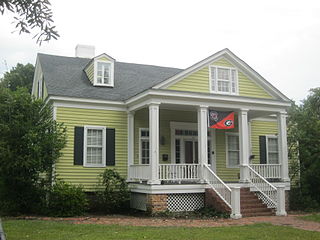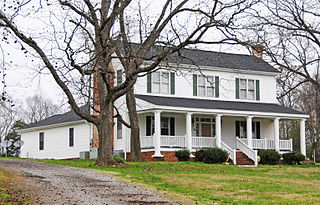
Kingstree is a city and the county seat of Williamsburg County, South Carolina, United States. The population was 3,328 at the 2010 census.
Nesmith is an unincorporated community in Williamsburg County, South Carolina, United States. It was a station on the Seaboard Air Line Railroad line which was built about 1912. Today it consists of a post office, fire station, and a country store, serving a large rural area which depends on agriculture and logging. Black Mingo Creek flows alongside the hamlet.

Stagville Plantation is located in Durham County, North Carolina. With buildings constructed from the late 18th century to the mid-19th century, Stagville was part of one of the largest plantation complexes in the American South. The entire complex was owned by the Bennehan, Mantack and Cameron families; it comprised roughly 30,000 acres (120 km2) and was home to almost 900 enslaved African Americans in 1860.

Salters is a small unincorporated community in the southwest central portion of Williamsburg County, South Carolina, United States, in the state's Low Country region. The zip code is 29590 and the area code is 843. Charleston, South Carolina and Myrtle Beach, South Carolina are within driving distance of Salters making for an enjoyable day trip to either. Forestry is the main industry in Williamsburg County. Nearby towns include Kingstree, Greeleyville, and Lane. Salters is the location of Federal Corrections Institution, Williamsburg. The Salters Plantation House was listed on the National Register of Historic Places in 2000.
Gamble House may refer to:

This is a list of the National Register of Historic Places listings in Williamsburg County, South Carolina.

Old Woodruff High School is a historic high school building located at Woodruff, Spartanburg County, South Carolina. It was built in 1925, and is a two-story, modified "H" plan stuccoed masonry building in the Collegiate Gothic style. It consists of a three-part center section with two perpendicular wings. The building has a flat roof with parapet, Gothic arches, recessed entrances framed by pointed arches. The building housed a high school until 1953 when Woodruff High School was constructed, then used as a middle school and later an elementary school. In 1978 the City of Woodruff acquired old Woodruff High School and adapted it for use as its city hall and police headquarters.

New Hope Farm, also known as New Hope Post Office and Snoddy Farm, is a historic farm complex located at Wellford, Spartanburg County, South Carolina. The main house was built in 1885, and is a one-story farmhouse with Folk Victorian decorative elements. It features a steeply-pitched pressed metal-shingled roof, weatherboard siding, and a wraparound hip-roofed porch. Also on the property is a complex of domestic and agricultural outbuildings dating from about 1885 to 1905. They include a small two-story frame servant's house, a smokehouse, a privy, a corn crib, a buggy barn and a garage.

Elizabeth White House is a historic home in Sumter, Sumter County, South Carolina. It was built about 1854, and is a 1 1/2-story vernacular Greek Revival cottage. The front facade features a pedimented one-story portico supported by four square columns. It was the home of artist Elizabeth White (1883-1976). Under the provisions of White's will, the property was transferred to the Sumter Gallery of Art for use as an art gallery.
Hillside is a historic home located near Carlisle, Union County, South Carolina. It was built between 1820 and 1830, and is a two-story, "L-shaped" Federal style clapboard structure. It features a central double piazza with slender Tuscan order wooden columns. It was enlarged about 1850. Also on the property are tall granite gate posts with folk art relief sculpture. The posts are believed to have been carved about 1861 by J. E. Sherman, a Union soldier who became ill and was left at Hillside to recuperate prior to the American Civil War. Also on the property are a hand-hewn barn, a well with modern well-house, and another small 19th century structure.

Cedar Bluff, also known as the Byrd Murphy House, is a historic home located near Union, Union County, South Carolina. It was built about 1790, and is a small, two-story, timber frame I-house. It features a one-story shed porch supported by square plank columns. A rear wing was added to the house after 1900.

Colonel John Gotea Pressley House, also known as the Pressley-Hirsch-Green House and Wylma M. Green House is a historic home located at Kingstree, Williamsburg County, South Carolina. It was built in 1855, and is a 1+1⁄2-story, weatherboard-clad Greek Revival style frame dwelling. The front facade features a “rain porch” and a dormer with a Palladian window. It was the home of Colonel John Gotea Pressley, a prominent local attorney, judge, and Confederate regimental field officer. It was listed in the National Register of Historic Places in 1997.

Scott House, also known as the Scott-Hauenstein House, is a historic home located at Kingstree, Williamsburg County, South Carolina. It was built about 1843, and is a two-story, three bay, frame building, sheathed in weatherboard, with a side-gabled roof and brick foundation. The front façade features a "Carolina" or "rain porch." Its builder was Joseph Scott, a wealthy planter, trustee of the Kingstree Academy, and politician. It is the oldest on-site house in Kingstree.

Thorntree, also known as the Witherspoon House, is a historic plantation house located at Kingstree, Williamsburg County, South Carolina. It was built in 1749 by immigrant James Witherspoon (1700-1765), and is a two-story, five-bay, frame "I-house" dwelling with a hall and parlor plan and exterior end chimneys. It features full-length piazzas on the front and rear elevations. To preserve it, the house was moved from an inaccessible rural site to Kingstree on land donated as a memorial park, known as Fluitt-Nelson Memorial Park. The house has been restored to its 18th-century appearance and is open to the public by appointment with the Williamsburg Historical Society.
McCollum-Murray House, also known as the C.E. Murray House, is a historic home located at Greeleyville, Williamsburg County, South Carolina. It was built about 1906, and is an example of transitional folk Victorian and Classical Revival residential architecture. It was originally a two-story, T-shaped dwelling. It features a wraparound one-story porch. It has a single-story rear gabled addition, with another single-story shed-roofed addition built in the 1950s. It was the home of African-American educator Dr. Charles Edward Murray.

John Calvin Wilson House is a historic home located near Indiantown, Williamsburg County, South Carolina. It was built about 1847, and is a two-story, five bay, frame central-hall plan I-house. It features a shed roofed, one-story "Carolina" or "rain porch" supported by four stuccoed brick columns. A one-story frame rear wing was added in 1939. John Calvin Wilson was a politician and a successful planter. He died at Richmond, Virginia of complications from a thigh wound sustained in the Battle of Cold Harbor.

M. F. Heller House, also known as the Arrowsmith House and Old Methodist Church Parsonage, is a historic home located at Kingstree, Williamsburg County, South Carolina. It was built about 1845 and enlarged about 1895 to a substantial two-story Late Victorian residence. It is a two-story, lateral-gabled residence, sheathed in weatherboard and set on a stuccoed brick pier foundation. It is the only antebellum residence built within the original limits of Kingstree.
Clarkson Farm Complex is a historic farm and national historic district located near Greeleyville, Williamsburg County, South Carolina. It encompasses 8 contributing buildings and 1 contributing site with buildings dating from about 1896 to 1928. They include the main house, store, smokehouse, garage, stable/garage, tenant house, pumphouse, wellhouse and pecan grove. The main house was built about 1905, and is a two-story, frame I-house on a brick pier foundation. The Clarkson Store was built about 1896, and is representative of one of few surviving rural commercial buildings. The pecan grove was planted in 1922.
New Market, also known as the McDonald-Rhodus-Lesesne House, is a historic home and national historic district located near Greeleyville, Williamsburg County, South Carolina. It encompasses 2 contributing buildings and 2 contributing sites. The house was built about 1820, and a one-story, frame extended Double Pen house over a raised brick basement. It features a typical "rain porch" on the front of the house supported by four tapered and chamfered wooden posts. Also on the property are a 1 1/2-story frame tobacco pack house, the foundation of a greenhouse, and a pecan avenue and grove.

Witherspoon-Hunter House is a historic home located at York, York County, South Carolina. It was built about 1825, and consists of a two-story, front section covered by a gable roof, with a one-story L-shaped rear annex. The house is of frame construction and rests upon a raised brick basement. It features a double-tiered front portico. Also on the property is a small brick building.

















